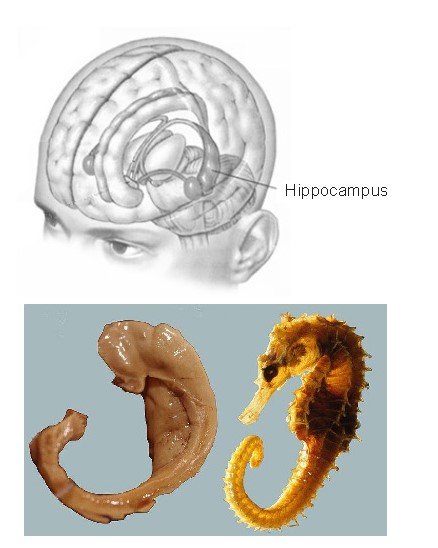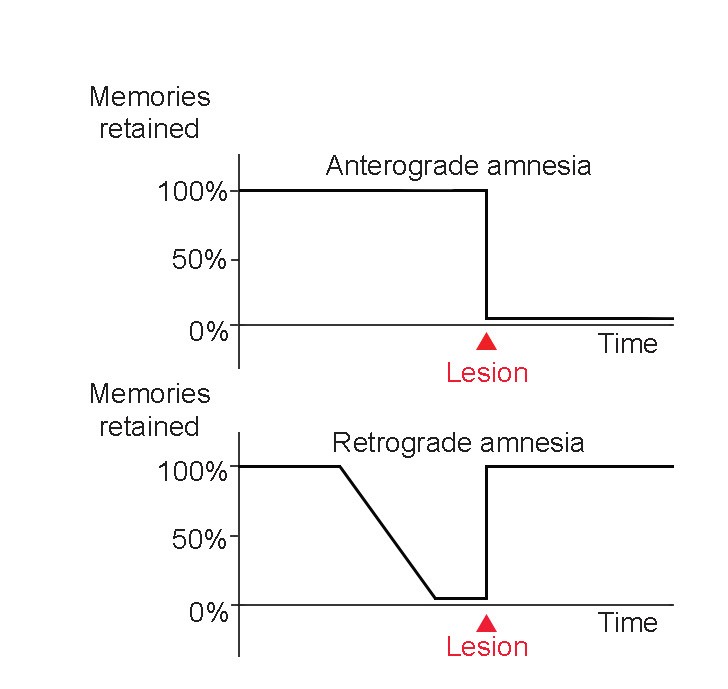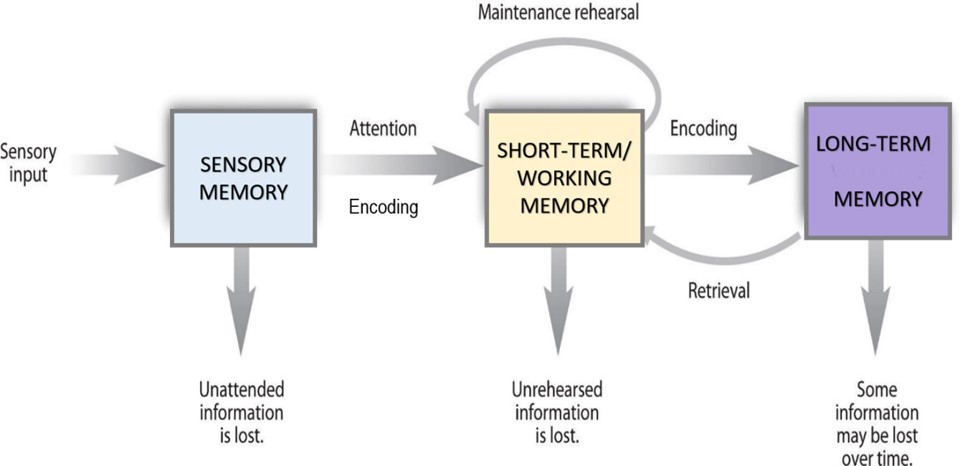Chapter 9: Learning and Memory
9.2: Patient HM
Patient HM

One of the most influential case studies in the neuroscience of memory is the story of Henry Molaison who died in 2008 at age 82 of respiratory failure. He was known as Patient HM. HM was born in 1926 in a small Connecticut town. He had a mostly regular childhood: taking family road trips, riding bicycles, and learning about American presidents in school. In his childhood, HM began having mild seizures, probably the result of a head injury when he was knocked down by a bike when he was seven years old. In his teenage years, he started having tonic-clonic seizures, the most severe form of seizures that produces a loss of consciousness and convulsions (extreme muscle contraction or extension). In his early adulthood, he was having a tonic-clonic seizure monthly and several minor seizures daily, preventing him from working a normal job or living a normal life – despite taking a cocktail of anti-epileptic medications.
Neurosurgeon William Scoville proposed a “frankly experimental operation” to treat HM. It was known that most epilepsy originates in patches of neurons of the medial temporal lobe (MTL), and HM’s epilepsy was typical in this respect. Scoville decided to surgically resect the MTL. In 1953, Scoville removed about 8 cm of the MTL bilaterally, including part of the amygdala, and notably the hippocampus, the seahorse-shaped structure of the brain.

The surgery succeeded at its primary goal: HM’s seizures were less frequent and less severe. However, HM was left with a highly unusual and life-altering side effect: He was unable to create new discrete memories, a memory deficit called anterograde amnesia. For example, he could not remember what he had eaten for lunch just minutes after finishing the last bite. Despite being an avid fan of watching the news, HM couldn’t remember the names or the faces of different celebrities or public figures. It was as if he was permanently living in the present. (In contrast, retrograde amnesia affects the ability to successfully retrieve memory from one’s past.) However, despite his pervasive memory deficits, HM did not display any deficits in intelligence. His language and speech were unaffected, and word recall was excellent, as he loved completing crossword puzzles and often did so successfully late in life, with only the occasional spelling errors. He could learn to acquire some new skills, such as keeping a pen still on a moving circular platform, or a tapping task (these skills are a different form of memory called procedural memory; see below). He was also capable of recalling things from his early childhood, such as geography facts he had learned in elementary school.
Types of memories
The fact that HM’s MTL surgery disrupted some types of memories (e.g., memory for facts) while others were still intact (e.g., motor skills) inspired neuropsychiatrists to try to define the different forms of memory. Much of the research was led by Dr. Brenda Milner, who carried out several behavioral tests on HM to figure out what types of memories are dependent on the intact MTL and which ones can function without MTL.
The most profound deficit was HM’s inability to create new declarative memories. Declarative memories, also called explicit memories, are the pieces of information that can be consciously declared or stated explicitly. Declarative memories are thought of as a “knowing what”. Declarative memories can be further subdivided into semantic memory and episodic memories.
Semantic memories are pieces of factual information. Some examples include:
- “Jupiter is the largest planet of our solar system.”
- “Rosalind Franklin discovered the double- helix structure of a DNA molecule.”
- “The actor Keanu Reeves played the protagonist of the movie The Matrix.”
An episodic memory, sometimes also called an autobiographical memory, is the recollection of a discrete moment in a person’s life. It can be thought of as “mental-time travel” – when we think back to specific events or episodes in our lives. The following memories are examples of episodic memories:
- “When I got home, I put my wallet and phone on the table.”
- “I ordered a pepperoni pizza last night.”
- “In 2019, I went to see my favorite musicians perform live.”
Several tests concluded that HM had lost his ability to create new semantic memories. In one such study, HM was asked to determine if a word was made up or real. He was shown common words that he had learned as a child, such as “shepherd” or “butcher.” On these words, he performed as well as the control group. When he was shown words that were made up, such as “phlage” or “thweise”, he likewise performed as well as the controls. However, when shown words that were added into the dictionary after his 1953-surgery, such as “granola” or “jacuzzi,” he scored about 50% correct – consistent with guessing at random, as if he never acquired the meaning of these words.
HM was also unable to create new autobiographical memories. When asked to recall one of his birthday celebrations as an adult, he wasn’t able to give any significant details about the event. Instead, his answers were often vague and generic.
One interesting observation was that HM’s memory about details from his childhood were still intact. The inability to recall memories from the past, in this case, from before HM´s surgery, is called retrograde amnesia. Patient HM’s retrograde amnesia was temporally graded, meaning that the farther back in time he went, the more complete his memories were. Many of his memories for the two years before his surgery were completely lost, but memories from his youth and teenage years were just as accurate as in healthy individuals (there is contention about this observation, because HM was taking several anti-epileptic drugs, which may have impacted memory formation.) From this observation, memory researchers concluded that the MTL functions as short-term storage site for memories, but after some years, those memories get relocated to other brain areas outside of the MTL. Currently, the scientific evidence suggests that memories are distributed across several networks of cortical and subcortical brain areas.

While HM lost the ability to create new explicit memories, he was still able to maintain a different class of memories, called implicit memories. They are unconscious memories, that are recalled without conscious effort. One class of implicit memories are procedural memories where we carry out series of actions without conscious thought. Procedural memories include brushing your teeth or riding a bike. People commonly call these “muscle memories”, even though the muscles do not store any actual memory — it is you brain that tells your muscles what to do! Another example of procedural memories involve the priming effect — where our recent experiences affect our thought processes without our conscious awareness. For example, if a person recently eats a banana, and then answers a fill-in-the-blank puzzle — “b _ _ _ _ _” . They are more likely to answer with “banana”, whereas other people might guess “bubble” or “booger”).

The original test of implicit memory conducted by Dr. Brenda Milner was called a procedural memory test called the mirror tracing task. In this test, the patient is told to draw a third star in between the two stars as quickly as possible without making any mistakes. The challenge is that the tracing is to be done while watching their hand and the star in their reflection in a mirror. Because of these unusual circumstances, completing this task is difficult. But over multiple days of practice, people become better at this mirror tracing task, completing it faster with fewer errors. Improvement on this task indicates that a person is learning or gaining some memory about how to better perform the task.

After practicing this mirror tracing task, HM was able to finish drawing the star about ten times faster than when he first began. He improved his performance within each day’s worth of training, and he also improved day-to-day. There is evidence that he maintained these skills up to one year later, despite not having regular training on this task. Surprisingly, each day Milner examined HM, she would need to reintroduce herself since he forgot who she was. She also had to re-explain what HM was supposed to do in the mirror tracing task. Hence, while HM was unable to form declarative memory about the experiment or the people involved, learning of the procedural memories and motor actions involved in this task remained intact.
Another type of implicit memory is an associative memory. Associative memories are the types of information that we learn through traditional classical conditioning. For example, you may recall learning about the classic Nobel prize-winning experiment in physiology conducted by Ivan Pavlov in the late 1800s. Pavlov accidentally discovered how animals learn. Pavlov was measuring the amount of saliva that dogs produced in response to various foods. However, over time, he also noticed that the dogs began to salivate not only at the taste of the food, but also at the sight of food or the food bowl, and even at the sound of the laboratory assistants’ footsteps (Pavlov, 1927). Salivating to food in the mouth is an automatic reflex, so no learning is involved. However, dogs do not naturally salivate at the sight of an empty bowl or the sound of footsteps—they had learned to make the associations. Let’s review the terminology that describes classical conditioning. The presentation of food causes a dog to salivate, a naturally happening behavior, which is called the unconditioned response (UR). The stimulus that produces the response is called the unconditioned stimulus (US). We can train a dog to salivate to a neutral stimulus– like the sound of a bell. Before training, the dog might look towards the bell and listen to it — but it’s not going to make them drool. The training is simple — we ring the bell each time before we feed the dog. At first, the bell has little effect, but when repeatedly paired with the food, the dog learns that the bell signals that food is coming and starts to salivate to the sound of the bell alone, this is called the conditioned response (CR). The bell has become a conditioned stimulus (CS).

Short-term/Working Memory
HM also had his working memory tested by the psychologists that worked with him. Working memory was traditionally called short-term memory, unlike long-term memory, it involves storing information temporarily. Working memory describes whatever we are thinking about in a given moment—in other words, what our minds are working on. As you can see in the model in Figure 9.8 information can enter working memory either from long-term memory (LTM) , i.e., what we already know) or from sensory memory (what is happening in our environment at a given moment).

Unlike long-term memory, working memory is very limited in how much it can hold and for how long. Most people can only hold about 7 +/- 2 pieces of information for about 30 seconds (unless they repeat it to themselves). After he recovered from his surgery, HM was able to perform as well as age-matched controls on working memory tasks.
For example, one test of working memory is the digit span test, where a person is given a series of numbers to remember, then they are asked to repeat the numbers in reverse order. After successfully completing this task, a different series of numbers, this time one digit longer, is presented to the patient until they first start making errors in recall. A related task is called the Corsi block tapping test, where an experimenter sets up several blocks on a table. The experimenter then taps a series of blocks in a specific order, then the subject is asked to tap the same pattern on the blocks, but in reverse order. As with the digit-span test, the experimenter then makes the number of blocks they tap longer until the participant make mistakes in the tapping.

